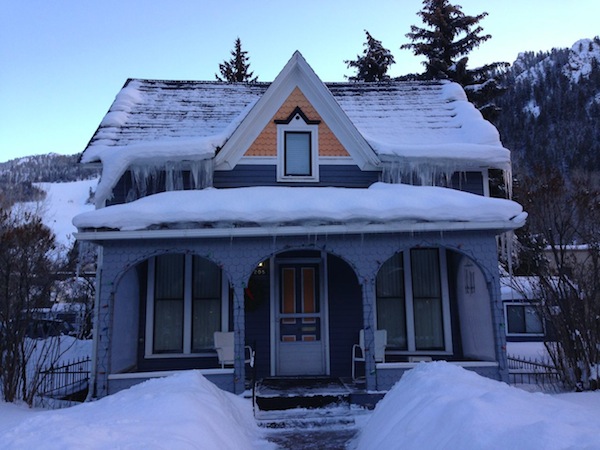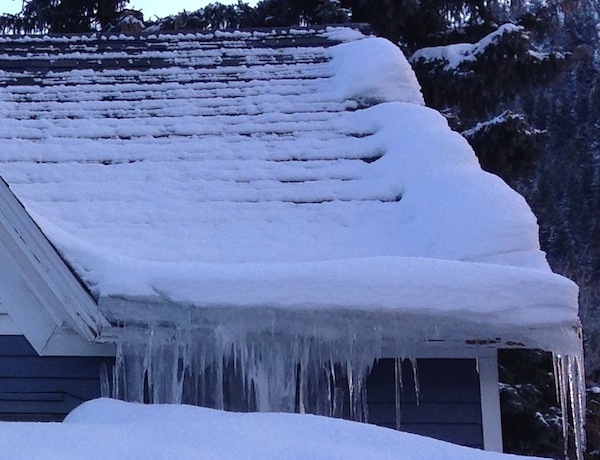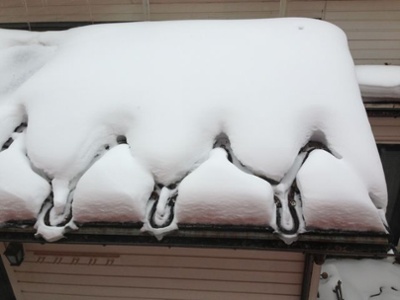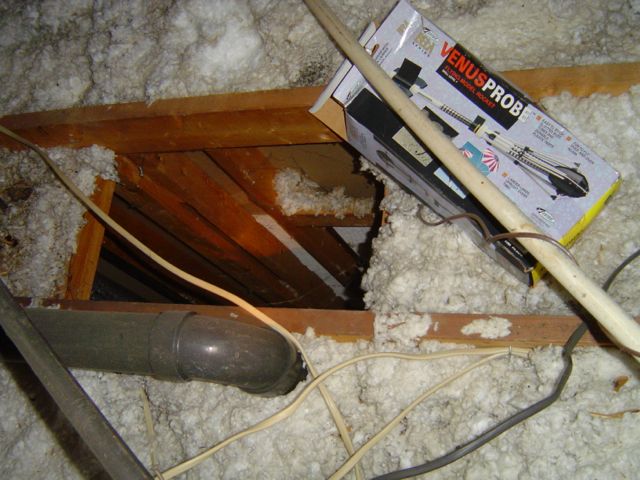When It Comes to Ice Dams, You CAN Fix Stupid!

They say you can’t fix stupid. They’re wrong. When it comes to ice dams, we know how to fix what is the most common cause.† If you know a little building science, you can look at the photo below and know immediately what’s going on here. Right?
What caused this problem?
It’s really pretty obvious in this case. As you can tell from all the snow on the ground and on the porch roof, this cute little house has seen a lot of snow already this year. It’s in a town in the Rocky Mountains of Colorado, and they’ve gotten 100 inches of the stuff since October.‡
Let’s look at the clues:
- Lots of snow on the ground and porch roof
- Not much snow on the main roof
- Less snow as you go toward the ridge
- More snow at the rakes and the eave
Why is the snow melting on the main roof? It’s over the attic. (I doubt this little house has vaulted ceilings and kneewalls with conditioned space up there because it looks like there’s not enough space.)
Why is the attic melting the snow on the roof? It’s too warm.
Why is the attic too warm? Heat from the house is leaking into the attic, either from air leakage or inadequate insulation or both.
Icicles aren’t cute

Take a look at this closeup of this house. Those icicles are damaging the trim on roof. All that water may be damaging the roof itself, too. Icicles aren’t cute. You need to fix the problem, and that doesn’t mean doing what they do on so many houses in this little town: electric resistance heaters on the roof.
Two bandaids and a solution
You can see the low-tech bandaid solution for this problem in the photo below. This fellow is using a snow rake on a long pole to pull the snow down off the roof. Yeah, if you get the snow off the roof, it won’t melt and create ice dams like you see above. But this town gets 200 to 300 inches of snow per year. I’d find another solution so I don’t end up with a mountain of snow in my front yard.

Bandaid solution #2 is worse. Here you compound the energy loss you’re already paying for with yet more wasted energy. You install electric resistance heaters around the edge of the roof, as shown below. A lot of houses in this town have these things. Hey, why not! They’ve got money to burn, and it’s easier than fixing the real problem.

No, the best way to fix this problem is to address the root cause. If heat leaking into the attic is melting the snow, you stop the leaks. Not all homes have such dramatic air leaks as you see in the photo below, but many do. Even if the holes are all smaller, you can still get a lot of it sealed up and greatly reduce the amount of heat leaking into the attic because of air leakage. In the photo below, the insulation is also inadequate. So first, seal the air leakage sites. Then add more insulation if necessary.

In new homes, get the attic sealed and insulated right the first time. If you’ve got a complex design with attic kneewalls and vaulted ceilings, pay attention to the details. Getting the building enclosure right isn’t a mystery.
It’s not rocket science. It’s building science. It’s just basic physics.
Allison A. Bailes III, PhD is a speaker, writer, building science consultant, and the founder of Energy Vanguard in Decatur, Georgia. He has a doctorate in physics and writes the Energy Vanguard Blog. He also has a book on building science coming out in the fall of 2022. You can follow him on Twitter at @EnergyVanguard.
Related Articles
Ice Dam Bandaid Solution: Heat Strips on the Roof
Guest Post: What Causes Ice Dams and Icicles?
Snow on the Roof – The Poor Man’s Infrared Camera
Footnotes
† Not all ice dams are the same. The great majority of them are probably due to ignorance about heat flow in buildings, as explained in this article. Sometimes, however, they’re caused by changing weather patterns or solar radiation.
‡ I took this picture last week while I was skiing, and the snow was wonderful! My friend there told me it’s the best snow they’ve had in 30 years. Of course, more snow means worse ice dams—or more energy used trying to melt the snow on the roof with heat strips.
Comments are closed.
This Post Has 18 Comments
Comments are closed.

Andrew, while having
Andrew, while having ventilation is a good thing, it is not a cure, just a band aid. Ventilation is only meant to remove excess heat & moisture from the attic, but for it to work properly you need to stop as much of the flow as you can upfront. Shoot I was in an attic this last week which was warmer than the basement.
As an FYI Allison in some cases raking a roof is necessary as they are only designed to hold so much. Gotta say I love those shots – nice job
I’m jealous you got to ski in
I’m jealous you got to ski in that snow!
This is such a common issue in cold climates and what you’ve shown is a pretty simple solution, but fixing these problems is more complicated when you have living space and knee walls on the top floor. My own house and nearly all the others in our neighborhood experience ice damming like the one pictured here. The repair you’ve shown for an un-conditioned attic can be dusty, awkward and uncomfortable but at least this work doesn’t typically disrupt life within the building. In a house with finished walls and living space upstairs, the fix involves tearing half the house apart to get access to the areas behind the walls/ceiling. This not only disrupts life in the building but also adds cost and grows the scope of work involved in fixing the root cause of ice damming. I think this is partly why so many homes still have this stupid problem.
It would be useful to see someone explore the other type of home in an article about ice damming. All too often the advice looks at the easiest type of house to fix. I’d like to hear some suggestions for a ‘cape’ style house. For example, is it practical to sneak into, and work inside those triangles of space behind the knee walls? Or is it easier to take the walls/ceiling down? Assuming you’ve stripped the interior to gain access, do you keep the thermal boundary behind the knee walls or move it all to the roofline? There’s lots more considerations in these types of homes – maybe another article idea for you!
Thanks for all you do, I enjoy your blog.
there is one thing that is
there is one thing that is always over looked in stopping ice dams and roof snow melt. That is the structural change that takes place. once the heat lose is stopped the snow weight on the roof increases. the roof may not have been designed to carry the extra snow load. may even have very few collar ties. I noticed in my own house. no damage, but was almost needing to address the issue when we hade along cold spell and a lot of snow. foe me the house is 50 years old fir framing and well constructe dbut heard is speaking under the extra load. Noticed it on a second home we have in the Mts. Shovels and chopping ice and snow is great for the reroofing business.
Oh snow! Those ice dams are
Oh snow! Those ice dams are good for one thing…covering up the fact that you stepped on your glasses after almost shooting your eye out.
I am all-too familiar with ice dams having grown up in Michigan.
In response to Sean’s comment about snow raking. For typical flat roof design allowable snow depth is 3-4 inches for every 10 psf of ground snow load on ASCE-7’s ground snow load map. That is 2 times the ground snow load in Atlanta, GA, however snow load in CZ 3 may not control. This value is 8-9 times less than that for Houghton, MI (Where I went to college), which receives similar snowfall to that mentioned above. The actual allowable load depends on several factors: site condition, building use, roof geometry, space conditioning, and insulation R-values.
Thanks Allison, another good one.
Andrew:
Andrew: Yes, attic venting can alleviate the symptoms, but as Sean said in comment #3, that’s still a bandaid solution. You’re still losing heat from the house; it just doesn’t build up as much in the attic.
Bob S.: I knew someone would take a closer look at that box!
Sean: Thanks! Yeah, structural considerations are certainly important, too.
Mark F.: Indeed, the more complex the building enclosure, the harder it is to solve the problems. That’s true for existing homes and for new homes. It’s certainly possible, though, to fix the problems, and companies like Snug Planet in Ithaca, New York, Energy Smart Home Performance in Mantua Ohio, and Energy Docs in Redding, California do it all the time. Thanks for the suggestion to write more about how to do it, Mark. Look for something here in the not-too-distant future.
Frank M.: Good point. That issue has already come up here in the comments, and it’s certainly worth paying attention to. I just saw one of those Allstate Mayhem commercials about excess snow load on TV.
Eric K.: I didn’t even know we had a ‘ground snow load’ here in Atlanta. In fact, I don’t think I’ve ever even heard the term. We might get a little snow this week, though.
Son Tom in Tahoe City has
Son Tom in Tahoe City has this situation on his 1950’s home, with a vaulted ceiling (that he luvs, thank you very much). I’m thinking tear-off of the aging shingles and a new underlayment of appropriate insulation.
BTW, all that snow in the Rockies is breaking my heart. Way into the third year of serious drought in NV/Tahoe and here’s the best we can do:
http://www.rgj.com/viewart/20140111/NEWS/301110025/Great-Basin-tribal-snow-dance-pays-off-Tahoe
Don’t want to go off the res, but has anyone tried the new IR app for smart phones? Another article for Allison’s fertile mind?
Best wishes all
Steve W.:
Steve W.: With vaulted ceilings, going through the top can be the best solution if the house is ready for a new roof. You could also take the opportunity to put rigid insulation on top of the roof deck.
Yeah, I know about your lack of snow. I’m going to be at Yosemite for a conference next month and was checking out places that I might be able to ski for a day or two while there.
Yeah, snow is not something
Yeah, snow is not something that comes around to often in the Southern united states. In Atlanta, you are probably more worried about freezing rain.
Snow events in design are accounted for in the following way.
WARNING: Involves talk of statistics.
The values on the ASCE7/IBC ground snow load map were determined using the annual extreme values found in historical data (At least 10 years). It accounts for the annual probability of such an event occurring over a 50 year mean recurrence interval(annual probability of occurrence of 2%).
In more relevant terms there is a 2% chance of the ground snow load from the map being exceeded over a 50 year period.
Other environmental loads (wind, earthquake) are accounted for in a similar way.
This is interesting stuff, but the key for any homeowner is to remember that the depth of the snow should not exceed 3-4 inches for every 10 psf on the ground snow load map.
I thought the Venus Probe
I thought the Venus Probe would solve the problem.
Suggest references on putting
Suggest references on putting rigid insulation on the roof deck to solve this problem.
I wrote a big article for JLC
I wrote a big article for JLC in January 2011 on the topic of ice dams. It dives deep into causes and solutions if anyone is interested and has an online subscription. It’s titled “Making a Business out of Ice Dams”. Otherwise, you might check out our website http://www.icedamcompany.com. I’ve been geeking out on this topic for the past 15 years and have come to a lot of conclusions that run contrary some commonly held beliefs. For example, ice and water membranes do little to stop ice and water (which is their entire purpose). Also, gutters have absolutely nothing to do with the formation or severity of ice dams. True story. Anyway, I’m happy to see JLC is continuing to bring attention to ice dams because they cause a lot of property damage every year.
tommyB: Some attics are
tommyB: Some attics are sealed (and part of the building’s interior, conditioned space), Thinking that a building needs to “breath” by uncontrolled leakage is outdated thinking and incorrect. I know of some perfectly sealed attics.
Take a look at Passiv Haus if you want to find out more. These homes are built without heating systems (or very tiny ones), and the homes are popular in Germany and the Netherlands where it is equally as cold.
Lifetime energy expense of most homes will total a million dollars or more, sometimes much more. Sealing a home properly add a few, small percent to the cost of a home and can save tens of percent. Plus, your home could be more comfortable and healthier.
Look into it.
I have been a subscriber now
I have been a subscriber now for 5 or 6 years and was a General at one time. I believe this article only covers the most obvious of ice dam issues. With the latest on being Green – or I would say sustainable – oreintation is a big issue for house placement on one’s property. I recently build my final home and it is facing, so the back of the home is southerly as to collect the sun’s warmth in the winter and shade in hte summer. What does this do for me in the winter for ice dams, it causes them. My attice has a R49, where R38 is code, my wall are R27, where R21 is code. I do live in Colorado and I don’t get 200′ – 300′ of snow each year. What happens is when the temps are below freezing at night and most of the day -daytime temps melt the snow on the peak of the roof and water flows to the gutters, in the evenings that water freezes and the process repaets each day the temps remain below freezing, resulting in ice dams on the north and shaded east side of my home. Having a roof rake would help to eliminate the snow; thereby, elinmating the ice dams. My point is, insulation and air sealing alone don’t not stop ice dams – they certainly help and save homeowners money, YES THEY DO! I would like you to address all the issues with ice dams and offer sound solutions to those issues. We can be an asset to homeowners wher they will come to folks like us for all their issues. I want them to see us through trusting eyes, not shady ones.
Mark E Correll, Sr.
Nice article. I will also
Nice article. I will also endorse Steve Kuhl’s JLC article and his expertise. As a fellow remodeling contractor, I know Steve’s work and knowledge in ice dam removal and remediation of primary problem.
A portion of my 2nd floor
A portion of my 2nd floor (dormer area)is unheated storage (8 ft high with sloping ceiling). It has unfinished sheet rock on the front wall and along the rafters. I have a continual problem of ice daming and water intrusion. Would it be a possible fix to put foam board on the sheet rock to increase the insulation and, hopefull, mitigate the ice dam formation?
It seems to me that IF your
It seems to me that IF your roofer knows what he is doing, applies everything correctly from the flashing, snow and ice barrier and roofing one will not have ice jambs in the first place. Right or wrong?
Nice Article but not entirely
Nice Article but not entirely accurate.
Even with good sofit ventalation and good insulation the right series of weather events can cause Ice Dams.
When whole neighborhoods experience Ice dams where they had had no problems in the past…It ain’t always Insulation!!!
John B.:
John B.: You’re absolutely right. That’s why I wrote: “Not all ice dams are the same. The great majority of them are probably due to ignorance about heat flow in buildings, as explained in this article. Sometimes, however, they’re caused by changing weather patterns or solar radiation.” See the first footnote.